The Garden
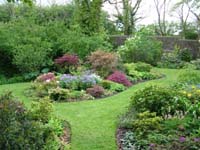 Acer Garden Gallery |
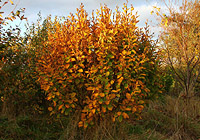 Arboretum Gallery |
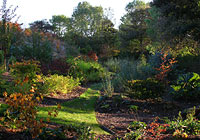 Dell Gallery |
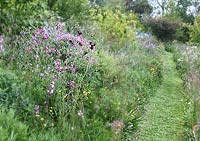 Nectar Bar Gallery |
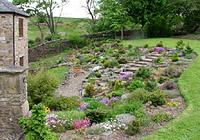 Rock Garden Gallery |
The garden is approx 1½ acres in size plus a similar sized meadow. Development of the gardens began in winter 2002 from a completely virgin site and is now maturing well. It is to be found at an elevation of 850ft and is situated in a natural hollow which protects much of it from the worst of the prevailing weather. Oliver burn runs through the garden creating additional interest.
Soil conditions are slightly acidic clay and the site receives plenty of precipitation. The overall feel of the garden is relaxed and contains no formality. It has been designed so that it blends into the surrounding countryside and there is an emphasis on wildlife friendliness.
The main elements of the garden are a large rock garden, nectar bar, woodland area with Japanese maples and rhododendrons, bog garden, stream, arboretum, meadow, winter bark walk and orchard. (See our Garden Plan)
The garden has been planted with a considerable number of trees and shrubs, the acidity lending itself to growing rhododendrons and Japanese maples. A number of rare species rhododendrons have been planted recently to mature into a glade by the stream.
Year-round Interest
The contents of the arboretum, as well as many of the other trees and shrubs, have been chosen with a view to add winter interest in the form of coloured, peeling or contorted stems. Consequently, there are a considerable number of snake-bark maples, birches, Prunus, Arbutus, Stewertia amongst others; many of which are rare in cultivation. There is also a winter walk with various coppiced dogwoods on one side and coppiced willows on the other. Near the rock garden a "rainbow" willow bed has recently been planted, providing a spectrum of stem colours in the winter, from red to blue(ish).
There is a good show of spring bulbs, particularly snowdrops and Narcisii, and the woodland garden is steadily being planted with an increasing variety of woodland perennials. The 80m2 rock garden is a tapestry of colour from spring onwards and is a showcase for a large number of dwarf conifers, which add structure and colour in the winter, again many of which are rare in cultivation.
A Wildlife Haven
Being in a rural location with a stream, the garden lends itself very well to being a wildlife haven. The site is managed to maximise its attractiveness to wildlife. The large nectar bar, which increases in size each year, has plants to attract insects from early spring (cowslips) to late summer (Helianthus). The shelter belts were planted with a high proportion of berry producing plants to attract birds as well as a large number of buddlia for butterflies.
The far end of the garden has been completely left alone and contains the wood pile. Nest boxes have been put up and there is a pond to entice a wide variety of wildlife. The natural upland meadow is full of wildflowers in spring and early summer, including a considerable quantity of yellow rattle. The more unusual birds that have been confirmed as breeding on the site include pied & grey wagtails, meadow pipit, tree sparrow, mistle thrush and grey partridge.

